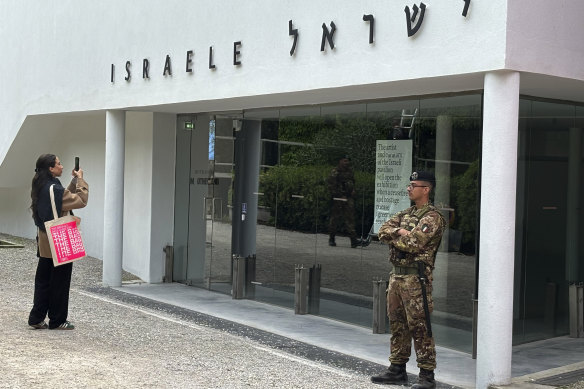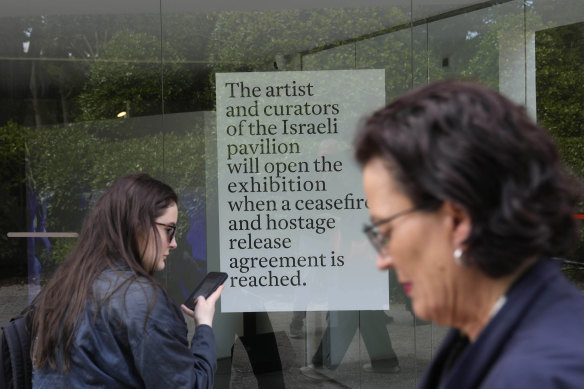Venice, Italy — Since February thousands of pro-Palestinian activists have tried in vain to get the Venice Biennale, one of the world’s most prestigious international art exhibitions, to ban Israel over its conduct of the war in the Gaza Strip.
But this week, when the Biennale’s international pavilions open for a media preview, the doors to the Israel pavilion will nonetheless remain locked, at the behest of the artist and curators representing Israel.

A woman takes a photo as an Italian soldier patrols the Israeli national pavilion at the Biennale contemporary art fair in Venice on Tuesday.Credit: AP
“The artist and curators of the Israeli pavilion will open the exhibition when a cease-fire and hostage release agreement is reached,” reads a sign that the Israeli team taped to the door of the pavilion.
“I hate it,” Ruth Patir, the artist chosen to represent Israel, said in an interview about her decision not to open the exhibit she has been working on, “but I think it’s important.”
She said that while the Biennale, which opens to the public on Saturday, is a huge opportunity for a young artist like herself, the situation in Gaza was “so much bigger than me,” and she felt that closing the pavilion was the only action she could take.
Although many Israelis share Patir’s desire for a ceasefire and hostage deal, a call for a ceasefire from an artist representing the country at an important international event could draw criticism from Israeli lawmakers, said Tamar Margalit, an Israel pavilion curator who reached the decision with Patir and Mira Lapidot, another curator of the pavilion.

A sign on the closed Israeli national pavilion on Tuesday.Credit: AP
Israel’s government, which has paid about half the pavilion’s costs, was not informed in advance about the protest, Margalit said. The Israeli Culture Ministry did not immediately reply to a request for comment Tuesday.
Margalit said visitors would still be able to see one of Patir’s video pieces through the pavilion’s windows. For that piece, Patir used computers to animate images of ancient fertility statues, which are a recurring motif in her work. The female statues, many cracked or missing limbs, come to life in the film and move around, wailing with grief and anger.
Read More: World News | Entertainment News | Celeb News
SMH









